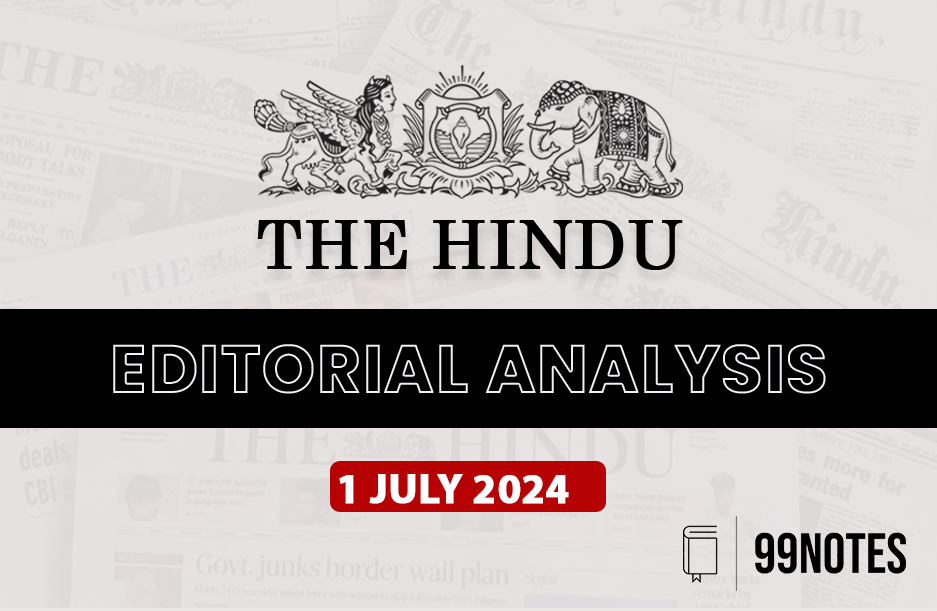1 July 2024 : The Hindu Editorial Analysis
1. Court on climate right and how India can enforce it
(Source – The Hindu, International Edition – Page No. – 8)
| Topic: GS2 – Indian Polity – Judiciary |
| Context |
|
Introduction to Ranjitsinh Judgment
- The Supreme Court of India has expanded India’s climate change jurisprudence by recognizing a constitutional right to ‘be free from the adverse effects of climate change’.
- This right is grounded in Article 21 (Right to Life) and Article 14 (Right to Equality) of the Constitution.
Context and Issue
- The case involved the construction of electricity transmission lines through the habitat of the endangered Great Indian Bustard.
- Government argued for modifying habitat protection orders to enhance renewable energy infrastructure.
Significance of the Judgment
- The court prioritised renewable energy development but introduced a groundbreaking ‘climate right’, empowering citizens to demand protection from climate impacts.
- This opens avenues for climate litigation against government actions detrimental to this right.
Challenges and Questions
- Uncertainties remain about whether clean energy alone can mitigate climate impacts, neglecting adaptation and local resilience strategies.
- Implementation and enforcement of the newly recognized climate right are crucial issues.
Prospects for Climate Legislation
Need for Climate Legislation
- India lacks comprehensive ‘umbrella legislation’ addressing climate change despite judicial recognition.
- Such legislation can provide a systematic framework across sectors and regions, unlike piecemeal judicial directives.
Advantages of Legislation
- Framework legislation can set a national vision for climate action, establish necessary institutions, and streamline governance processes.
- It can integrate climate considerations into urban planning, agriculture, water management, and energy sectors, promoting resilience and low-carbon growth.
Tailoring Legislation to Indian Context
- Legislation should not blindly replicate models from other countries but should address India’s unique vulnerabilities and developmental needs.
- It must balance mitigation efforts with robust adaptation strategies tailored to local conditions.
Types of Climate Legislation
Regulatory vs. Enabling Legislation
- Regulatory laws, like those in the UK, focus narrowly on emissions control, whereas enabling laws, as seen in Kenya, stimulate holistic development aligned with climate resilience.
- An enabling law in India would promote procedural frameworks for transparency, public participation, and target-setting across diverse ministries and sectors.
Institutional Framework
- The law should facilitate knowledge-sharing, ensure transparency in decision-making, and encourage expert consultation.
- It should include mechanisms for setting and revising climate targets, and reporting on progress, ensuring accountability.
Federalism and Local Governance
Adaptation to Federal Structure
- Given India’s federal governance, climate legislation must strike a balance between national coherence and empowering state and local governments.
- It should decentralise decision-making while providing resources and support for effective climate action at sub-national levels.
Inclusive Participation
- Beyond government, businesses, civil society, and local communities must be integral to climate decision-making.
- The law should enable diverse stakeholders to contribute knowledge and perspectives, enhancing the effectiveness of climate initiatives.
Path Forward
- An effective Indian climate law should blend regulatory and enabling approaches, prioritising both mitigation and adaptation.
- It must be tailored to India’s federal structure, promoting coherent national action while empowering local entities.
- By fostering inclusive governance and addressing sector-specific challenges, such legislation can fulfil the promise of the Ranjitsinh judgement and advance India’s climate resilience and sustainable development goals.
| PYQ: Clean energy is the order of the day. Describe briefly India’s changing policy towards climate change in various international fora in the context of geopolitics.(250 Words /15 marks) (UPSC CSE (M) GS-2 2022) |
| Practice Question: Discuss the significance of the Supreme Court’s ‘climate right’ as articulated in the M.K. Ranjitsinh judgement. How can potential climate legislation in India address the dual imperatives of mitigation and adaptation? (250 Words /15 marks) |
2. The rot in India’s higher education system
(Source – The Hindu, International Edition – Page No. – 8)
| Topic: GS2 – Social Justice – Education |
| Context |
|
Introduction
- The introduction of the National Testing Agency (NTA)-run Common University Entrance Test (CUET) in 2022-23 caused significant delays in admissions across Indian universities, including PhD programs.
- Jawaharlal Nehru University (JNU) faced challenges despite its historical autonomy in conducting entrance exams.
Delays and Administrative Challenges
- PhD admissions for 2022-23 were delayed until mid-March 2023, disrupting the academic calendar by eight months.
- Initially planned CUET for PhD admissions in 2022-23 was cancelled abruptly, leaving universities uncertain and unprepared.
Regulatory Changes and University Autonomy
- University Grants Commission (UGC) Regulations, 2022, reinstated universities’ rights to conduct their own PhD entrance exams.
- Despite this, several Central universities, including JNU, continued to use NTA for PhD entrance exams, citing executive decisions over academic autonomy.
Role of NTA and Executive Decisions
- NTA’s influence extended through executive directives despite opposition from university faculty and students.
- JNU, known for its rigorous and fair entrance exams, faced pressure to conform to NTA’s standardised testing format.
Controversies and Lack of Transparency
- The Ministry of Education and UGC’s contradictory stances on NTA involvement and university autonomy created confusion.
- Lack of documented contracts or agreements between JNU and NTA raised questions about decision-making processes.
Impact on Academic Calendar and Governance
- NTA’s control over university academic calendars led to disruptions and compromised traditional admission timelines.
- Vice-Chancellors’ compliance with NTA directives raised concerns about preserving university autonomy and academic integrity.
Call for Reform and Restoration of Autonomy
- Calls from academic bodies and stakeholders for universities to reclaim autonomy in admissions decisions, especially for PhD programs.
- Need for transparency in decision-making processes to restore student and faculty confidence in higher education governance.
Conclusion
Addressing Challenge
- Reforms should focus on clarifying regulatory frameworks and ensuring adherence to statutory university processes.
- Restoring autonomy in admissions processes, particularly for PhD programs, is crucial for maintaining academic standards and integrity in Indian higher education institutions.
| PYQ: The quality of higher education in India requires major improvements to make it internationally competitive. Do you think that the entry of foreign educational institutions would help improve the quality of higher and technical education in the country? Discuss. (200 words/12.5m) (UPSC CSE (M) GS-2 2015) |





